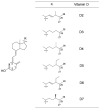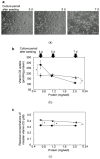Uptake of Vitamins D2, D3, D4, D5, D6, and D7 Solubilized in Mixed Micelles by Human Intestinal Cells, Caco-2, an Enhancing Effect of Lysophosphatidylcholine on the Cellular Uptake, and Estimation of Vitamins D' Biological Activities
- PMID: 33805560
- PMCID: PMC8067314
- DOI: 10.3390/nu13041126
Uptake of Vitamins D2, D3, D4, D5, D6, and D7 Solubilized in Mixed Micelles by Human Intestinal Cells, Caco-2, an Enhancing Effect of Lysophosphatidylcholine on the Cellular Uptake, and Estimation of Vitamins D' Biological Activities
Abstract
Vitamins D have various biological activities, as well as intestinal calcium absorption. There has been recent concern about insufficient vitamin D intake. In addition to vitamins D2 and D3, there are lesser-known vitamins D4-D7. We synthesized vitamins D5-D7, which are not commercially available, and then evaluated and compared the mixed micelles-solubilized vitamins D uptake by Caco-2 cells. Except for vitamin D5, the uptake amounts of vitamins D4-D7 by differentiated Caco-2 cells were similar to those of vitamins D2 and D3. The facilitative diffusion rate in the ezetimibe inhibited pathway was approximately 20% for each vitamin D type, suggesting that they would pass through the pathway at a similar rate. Lysophosphatidylcholine enhanced each vitamin D uptake by approximately 2.5-fold. Lysophosphatidylcholine showed an enhancing effect on vitamin D uptake by reducing the intercellular barrier formation of Caco-2 cells by reducing cellular cholesterol, suggesting that increasing the uptakes of vitamins D and/or co-ingesting them with lysophosphatidylcholine, would improve vitamin D insufficiency. The various biological activities in the activated form of vitamins D4-D7 were estimated by Prediction of Activity Spectra for Substances (PASS) online simulation. These may have some biological activities, supporting the potential as nutritional components.
Keywords: Caco-2 cells; PASS; intercellular barrier formation; intestinal uptake; lysophosphatidylcholine; mixed micelles; vitamin D.
Conflict of interest statement
The authors declare no conflict of interest.
Figures







Similar articles
-
Organic Synthesis of New Secosteroids from Fucosterol, Its Intestinal Absorption by Caco-2 Cells, and Simulation of the Biological Activities of Vitamin D.Mar Drugs. 2023 Oct 17;21(10):540. doi: 10.3390/md21100540. Mar Drugs. 2023. PMID: 37888475 Free PMC article.
-
Simultaneous Synthesis of Vitamins D2, D4, D5, D6, and D7 from Commercially Available Phytosterol, β-Sitosterol, and Identification of Each Vitamin D by HSQC NMR.Metabolites. 2019 Jun 6;9(6):107. doi: 10.3390/metabo9060107. Metabolites. 2019. PMID: 31174367 Free PMC article.
-
Effects of mixed micellar lipids on carotenoid uptake by human intestinal Caco-2 cells.Biosci Biotechnol Biochem. 2012;76(5):875-82. doi: 10.1271/bbb.110777. Epub 2012 May 7. Biosci Biotechnol Biochem. 2012. PMID: 22738952
-
Vitamin D in Nature: A Product of Synthesis and/or Degradation of Cell Membrane Components.Biochemistry (Mosc). 2018 Nov;83(11):1350-1357. doi: 10.1134/S0006297918110056. Biochemistry (Mosc). 2018. PMID: 30482146 Review.
-
Absorption mechanisms for fat-soluble vitamins and the effect of other food constituents.Prog Clin Biol Res. 1981;77:119-35. Prog Clin Biol Res. 1981. PMID: 7038701 Review. No abstract available.
Cited by
-
The Action of Vitamin D in Adipose Tissue: Is There the Link between Vitamin D Deficiency and Adipose Tissue-Related Metabolic Disorders?Int J Mol Sci. 2022 Jan 16;23(2):956. doi: 10.3390/ijms23020956. Int J Mol Sci. 2022. PMID: 35055140 Free PMC article. Review.
-
Organic Synthesis of New Secosteroids from Fucosterol, Its Intestinal Absorption by Caco-2 Cells, and Simulation of the Biological Activities of Vitamin D.Mar Drugs. 2023 Oct 17;21(10):540. doi: 10.3390/md21100540. Mar Drugs. 2023. PMID: 37888475 Free PMC article.
-
Drug Screening, Oral Bioavailability and Regulatory Aspects: A Need for Human Organoids.Pharmaceutics. 2021 Aug 17;13(8):1280. doi: 10.3390/pharmaceutics13081280. Pharmaceutics. 2021. PMID: 34452240 Free PMC article. Review.
References
MeSH terms
Substances
Grants and funding
LinkOut - more resources
Full Text Sources
Other Literature Sources
Medical

